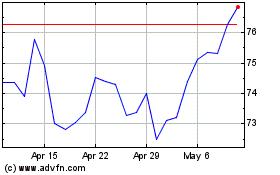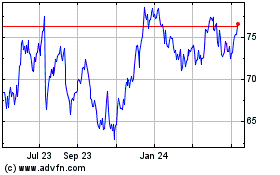UPDATE: Fed Report Cites Progress In Bank Pay Limits
October 05 2011 - 12:22PM
Dow Jones News
The largest U.S. financial companies have made progress in
reforming their pay practices to limit incentives for risky
behavior, but need to do more to comply with new guidelines set by
bank regulators last year, a Federal Reserve report says.
The Fed released the report Wednesday on risk-taking incentives
in the financial-services industry for top executives and
rank-and-file workers alike.
After the financial crisis of three years ago, lawmakers and
regulators in the U.S. began looking at executive and employee
compensation at financial firms to try to stamp out any pay
practices that could lead toward dangerous behavior, such as bets
on complex financial products that threatened the financial system
in 2008.
Federal regulators adopted guidance on incentive compensation in
June 2010 and have been requiring large companies to develop plans
to fix weaknesses in their compensation practices. While the banks
have made progress, the report said, "most firms still have
significant work to do" to comply with the new guidelines.
The report comes as pay practices on Wall Street have continued
to be a contentious public issue. Anti-Wall Street protests in New
York and other U.S. cities have put a spotlight on pay and bonuses
for financial executives, while the nation struggles with a weak
economy and the threat of a double-dip recession.
Before the financial meltdown, regulators allowed firms to
determine pay themselves. But pay is now seen as a factor that
could make a firm and the broader financial system vulnerable to
collapse.
The Fed said all 25 large financial firms reviewed made
progress. "All firms in the horizontal review now recognize the
importance of establishing sound incentive compensation programs
that do not encourage imprudent risk taking for those employees who
can individually affect the risk profile of the firm," the report
said.
Common changes include adjusting incentive compensation for the
risk an employee's activities could pose, deferring payouts to take
into account whether the employee's activities wind up producing
profits or loses.
For example, senior executives, on average, now have deferred
more than 60% of their incentive compensation, higher than an
international guideline. More senior executives, the report said,
have more than 80% deferred, the report said.
Before the financial crisis, it noted, most firms didn't pay
much attention to risk-taking incentives, or only examined pay for
the most-senior employees. But now the firms are "attentive to
risk-taking incentives for large numbers of employees below the
executive level," the report said.
The report, however, said there is still work to be done. "Some
firms are still working to identify a complete set of mid- and
lower-level employees, and others are working to ensure their
process is sufficiently robust," the report said.
The report examined pay practices at Ally Financial Inc.,
American Express Co. (AXP), Bank of America Corp. (BAC), Bank of
New York Mellon Corp. (BNY), Capital One Financial Corp. (COF),
Citigroup Inc. (C), Discover Financial Services (DS) Goldman Sachs
Group Inc. (GS) J.P. Morgan Chase & Co. (JPM) Morgan Stanley
(MS) Northern Trust Corp. (NTRS), PNC Financial Services Group Inc.
(PNC) State Street Corp. (STT) SunTrust Banks Inc. (STI) U.S.
Bancorp (USB) and Wells Fargo & Co. (WFC).
It also examined the U.S. operations of Barclays PLC (BARC.LN,
BCS), BNP Paribas SA (BNP.FR, BNPQY), Credit Suisse Group AG
(CSGN.VX, CS), Deutsche Bank AG (DBK.XE, DB), HSBC Holdings PLC
(HSBA.LN, 0005.HK, HBC) Royal Bank of Canada (RY.T, RY), The Royal
Bank of Scotland Group PLC (RBS.LN, RBS), Societe Generale SA
(GLE.FR, SCGLY), and UBS AG (UBSN.VX, UBS).
-By Alan Zibel, Dow Jones Newswires; 202-862-9263;
alan.zibel@dowjones.com
State Street (NYSE:STT)
Historical Stock Chart
From Jun 2024 to Jul 2024

State Street (NYSE:STT)
Historical Stock Chart
From Jul 2023 to Jul 2024
